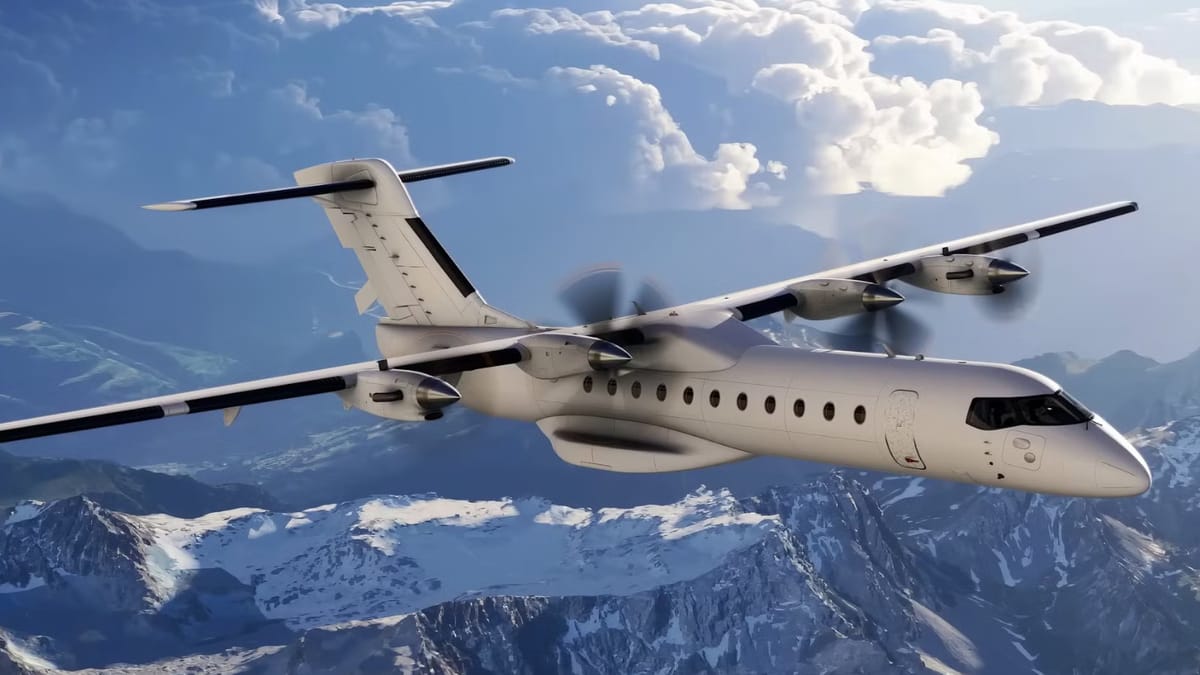
So many games ask you to bring your own fun, with simulators being chief among them. Most of the time, that’s just fine. With the literal world at your fingertips, jumping into the cockpit of dozens of aircraft is literally a never-ending source of amusement. I have spent countless hours in the virtual sky, and Microsoft Flight Simulator 2020 (our review) is one of the games that got me through the global pandemic. Fast forward to 2024 and the team at Asobo have given their game another face lift. By all accounts, the game has had a bit of a lean mixture start, sputtering in the stop zone ahead before it could enter the runway. Now, a week after launch, we’re finally clearing this one to enter the runway. Prepare to taxi – we’re cleared for flight with Microsoft Flight Simulator 2024.
One of the primary complaints people had with the first game was that it was a heavy install, taking up 150GB of storage. Given that storage has never been cheaper or faster, I can’t say I shared that same feeling, but just the same Asobo set out to lean into the formidable streaming technologies afforded by this being a Microsoft-published product. Azure would allow users a far smaller install footprint, pulling in only the assets needed to render where you’re flying, and leaving the rest off your drive. As such, Microsoft Flight Simulator 2024 takes up a remarkably small amount of install space. A quick look at my local install showed the game only using 11.68 GB, which is frankly insane. It’s using less than Dragon Quest III: HD-2D Remake (16.69 GB), Planet Coaster 2 (17.86GB), and Frostpunk 2 (14.21 GB), and FAR less than the likes of Cities: Skylines II (61GB), MechWarrior 5: Clans (71GB), Dragon Age: The Veilguard (90.3 GB), and Warhammer 40,000: Space Marine 2 (67.22 GB). I guess what I’m saying is, if you’re willing to spend hundreds if not thousands of dollars on simulation gear, a hard drive is far from a worry – let us have an “install it all” option. The result was a launch that had scores of fans stacked up trying to log in, download, and play the game as they tried to stream not only the game, but tons of realtime telemetry data to their machines. Now, a week out, what’s that experience like?
Well…so the saying goes, your mileage may vary, but my experience is very similar to Microsoft Flight Simulator 2020 – a longer initial load time, followed by 7-10 seconds of load time between sequences and an otherwise seamless experience. Still – those of us who’d rather skip the streaming bits in favor of a faster local copy could use an “install it all” option, please. We’re all tired of watching the game stall at “Activating Packages”.
There is a great deal of new content in this outing beyond the streaming technology, so let’s start with the biggest addition – a career mode. While bringing your own fun is still very much an option, with the “Fly Now” button waiting like an instant action button, the career mode represents not only a great play for new and returning players to get used to flying, but also an excellent way to learn a whole lot of new ways to play. Friends that came over and saw just how daunting it was to go from a Cessna to a Boeing 747. Since the Personal Pilot License (PPL) training only covers the basics and instrumentation on a single prop light plane and not commercial aircraft, I had little to offer them. Now, there’s a whole new game embedded in the game.
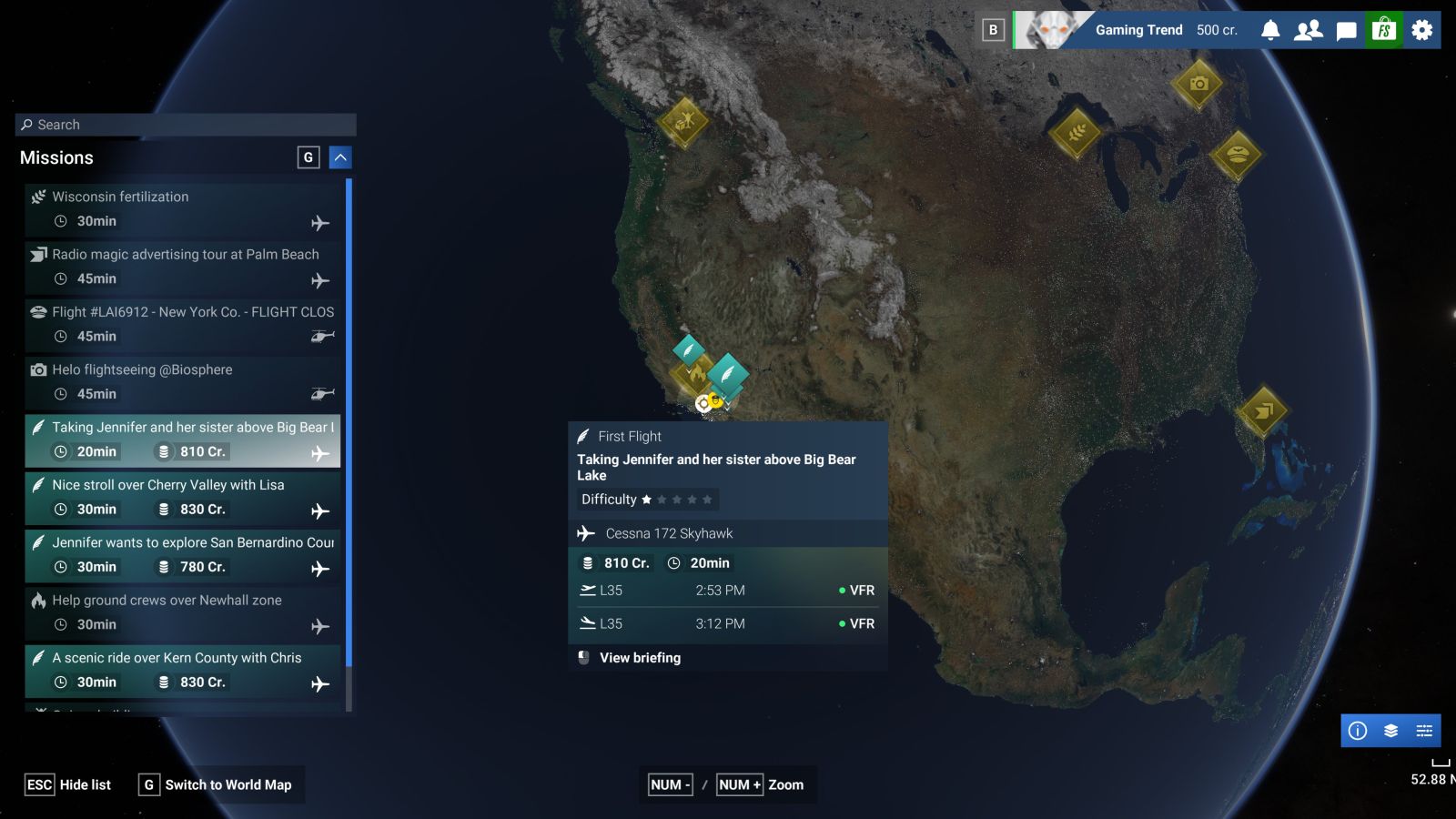
Career Mode is cleverly tucked behind a button that says (and stick with me here…) “Career Mode”. Inside you’ll find the aforementioned training for the Cessna covering basic instrumentation, ground inspection, taxi, normal takeoff and climb, regular approach, crosswind approach, a simple VFR go-around pattern, and a landing on a bright sunny wind-free day. Nailing these, you get a solo flight. At this point you can repeat any of these training flights (each about 4 minutes in length for bite-sized training), and when you’re ready, buy yourself an attempt at your PPL. You spend credits earned in-game (no, you can’t buy this with real money – there are no gameplay microtransactions) to buy the initial attempt, but can re-attempt it for free as many times as you’d like. This test gives you a chance to showcase everything you’ve learned, culminating in a numerical score out of a million possible points, and a letter grade to go with it. Other than a very shaky turn through the gravel that somehow didn’t cause me to fail, I think I did pretty well. Judge for yourself, but I’m gonna hang my license on the wall just the same.
With my certification complete I was presented with a whole array of possible career paths called “Specializations”. Additionally, I could also tackle missions to help my character (and my real-world skills) grow, earning XP that would allow me to level up. The first mission is a simple one – a pilot that was offering a “flightseeing” hop had to cancel and you’ll be pitching in to help showcase the area around Edwards Air Force Base. It’s a takeoff, four easy turns, one sharp turn, and a landing – simple enough. These missions grow in complexity, with a star rating to match. Sometimes it’s a difficult approach with crosswind, or perhaps a difficult twisty landing pattern, but you’ll not want to skip these flights as they’re building muscle you’ll need for larger aircraft.
With a few flights under my cap, it was time to get back to my Specialization choices. The First Flight options would give me a taste of various planes beyond the Cessna 172 Skyhawk. Once I completed my initial exam I could then repeat it with a JMB Aircraft VL-3, a Flight Design CTSL, a Pipistrel Virus SW121, or a Robin DR400. As I leveled up, I could then decide if I wanted to jump to my Commercial Pilot License for Rotocraft, or a Commercial Pilot License for Airplanes. With that choice made, the world is your oyster.
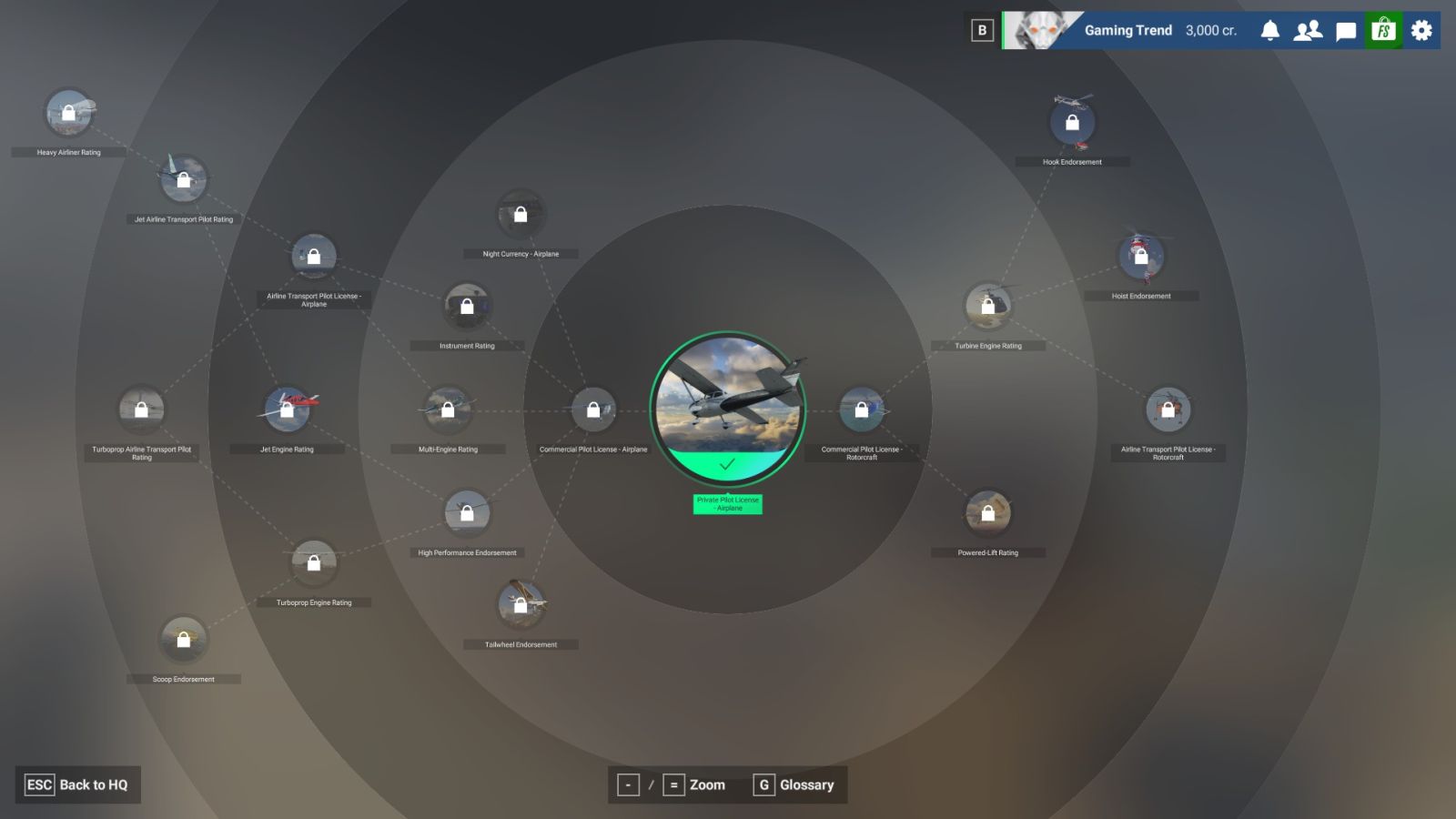
On the airplane side I start Night Currency training, which would certify me to fly passengers at night, or Instrument Rating, which would teach me to navigate without visual references (meaning I’d no longer be grounded by cloudy, rainy, snowy, or poor visibility conditions). Similarly, Multi-Engine ratings, High Performance Endorsements, and Tailwheel endorsements would open up even more missions, plane types, and the ability to tackle more complex flights. Turboprop, Jet Engine, Airline Transport, Scoop, and multiple certifications around heavier aircraft provided training and practice for more and more complex and challenging aircraft, but doing so with a methodical and cumulative effect that ensures you aren’t overwhelmed by the progression.
The other side of the coin is a completely new branch of flight – rotary craft. That means helicopters, turbine engine, powered-lift, airline transport, hoist training, and hook endorsements. I found that this builds on the skills I’d honed on the other side of the coin, building on the lessons learned to allow me to tackle passenger flights, rescue operations, fire fighting, commercial construction, and more. There is a complexity to helicopters that remains challenging for pilots long after they’ve become skilled in fixed-wing flight. It’s great that it’s now captured here.
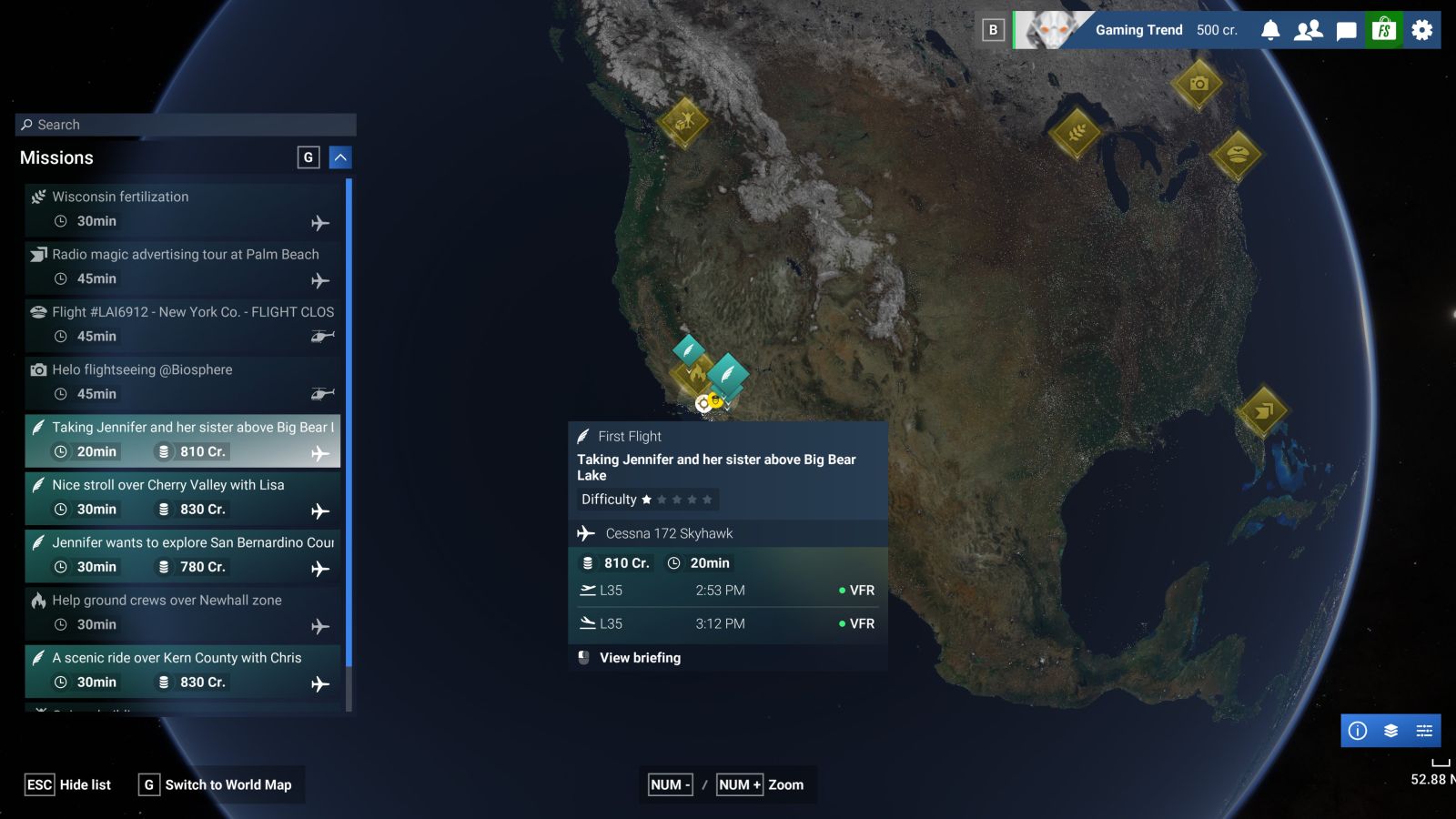
All of these training missions, endorsements, and opportunities have prerequisites. Completing all of these prerequisites and training opportunities will eventually culminate in the ability to open your own aviation company. Until then, you’ll be working for whatever flying club you’re currently assigned at that point in your career. Doing well in a mission will provide a base amount of credits as income, then your employer takes a serious cut, you get a small bonus for your reputation, and then you can earn bonuses for not skipping any part of the flight. These credits are used to take certification exams, ensuring the player takes some time to learn their craft before making a half-hearted attempt. You can also take a hit to your reputation if you do a poor job, so pay attention when someone asks you to “respect the condition of the aircraft” while doing a flight check. Opening your own shop means you take the lion’s share of the credits, making your progression and cross-training that much easier.

Everything you’re doing in your career is being observed by the simulation. It has the chilling effect of making you try to play the game properly, but it’s also teaching you how. If you lower your flaps before reducing speed, you’ll see a pop-up about that performance. If you taxi without lights, you’ll again see a warning. Landing speed, smoothness of flight, announcements and replies, how fast you climb on initial ascent, etc. all culminate in various score percentages out of 100, which is then combined for a letter grade – C, B, A, and even S if you do particularly well. It reinforces the fundamentals of flight, like having a mostly-silent instructor in the seat next to you.
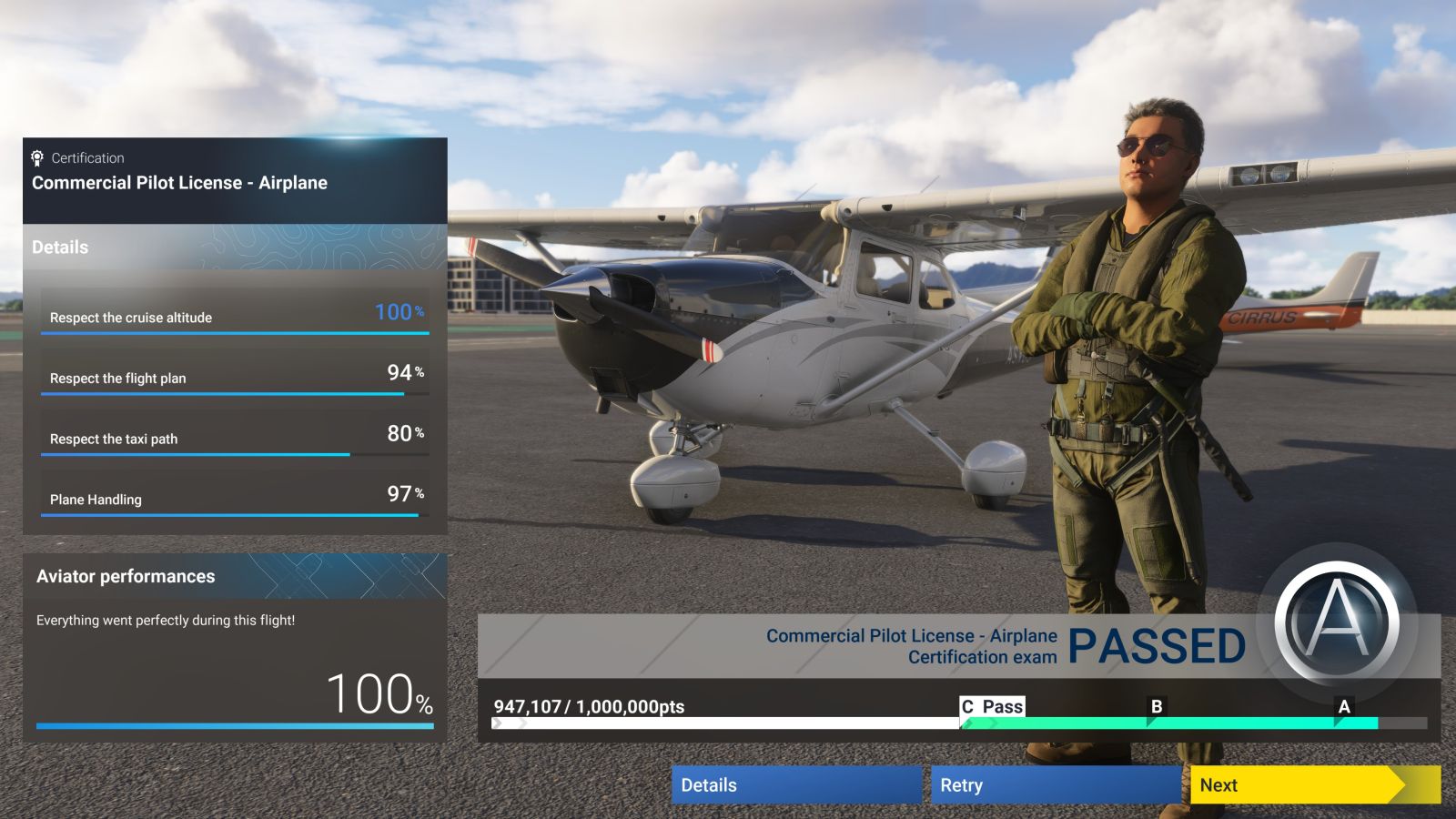
Just don’t ask to see my test for rotary craft…
While I’m sure it’ll all get patched over time, there are a wide variety of bugs to choose from at launch, even after a few patches. Accessing the mission list, I’d occasionally find myself in space, with no way to access the globe – the mission list, devoid of any missions to select, with only a restart able to fix it. Occasionally a mission would come up with no prerequisites, briefing, details, or ability to start it. The AI-powered voice has hiccups like “No easy to impress the locals” instead of “Not”, meaning it’s just a typo being read by the system, but it sticks out. There are more obvious ones like being dinged for not having landing lights turned on for night landing, even though I’m flying in broad daylight. I’ve had people in the ground crew clip half way through the ground, and on one occasion was roaring down the runway to take off only to have my plane suddenly phase through the ground and “crash”. The notes on these first few patches address page upon page of issues, so the team is well aware and working to resolve it. It’s just immersion breaking until they are. Thankfully they are infrequent, other than the VO work, which is every single time.
The issues with streaming rear their ugly head occasionally, sometimes literally. I’ve been to Las Vegas more times than I can count and I can honestly say that no matter how much I drank it never looked like a melted candle. When streaming isn’t working quite as intended, the familiar landmarks and hotels look like something Salvador Dali might paint, all strange angles and primitives. The amazing Great Pyramids of Giza have a distinct…well…pyramid shape. Or at least they do when streaming is delivering the world properly. Downtown London also has very recognizable landmarks, but they look like they occasionally got hit with a blowtorch. Once again, let’s skip this step – let me just download the world, please. I can take it.
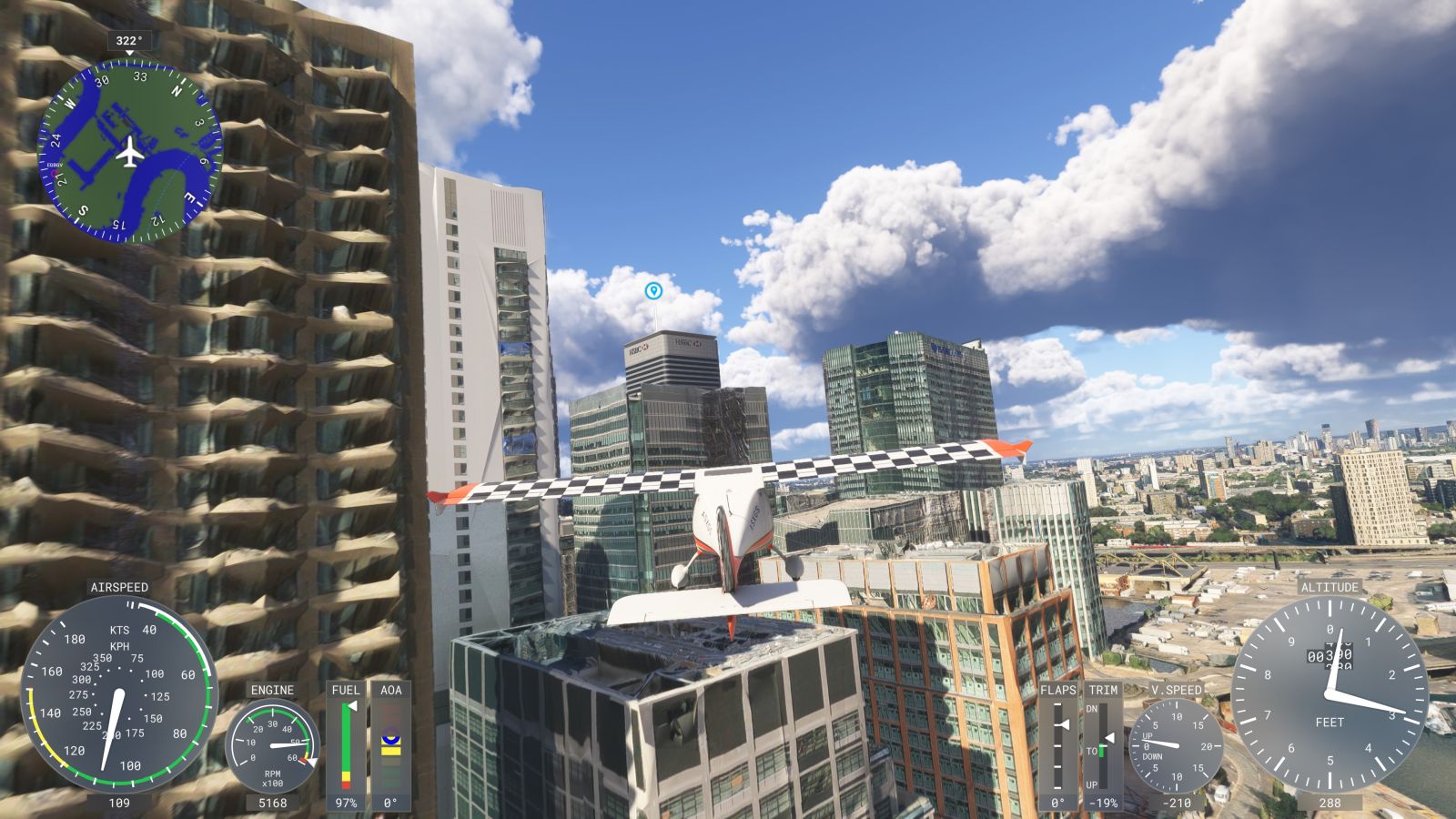
Beyond the career, which is admittedly extensive, there is also a Challenge League, Activities, World Photographer, and Free Flight. Challenge League lets you perform a number of activities that closely resemble the progression of a Season you’d find in a game like Diablo IV or Halo: Infinite. Completing these lets you climb from Bronze to Silver to Gold and so on. These are logged on a leaderboard globally or against your friends.
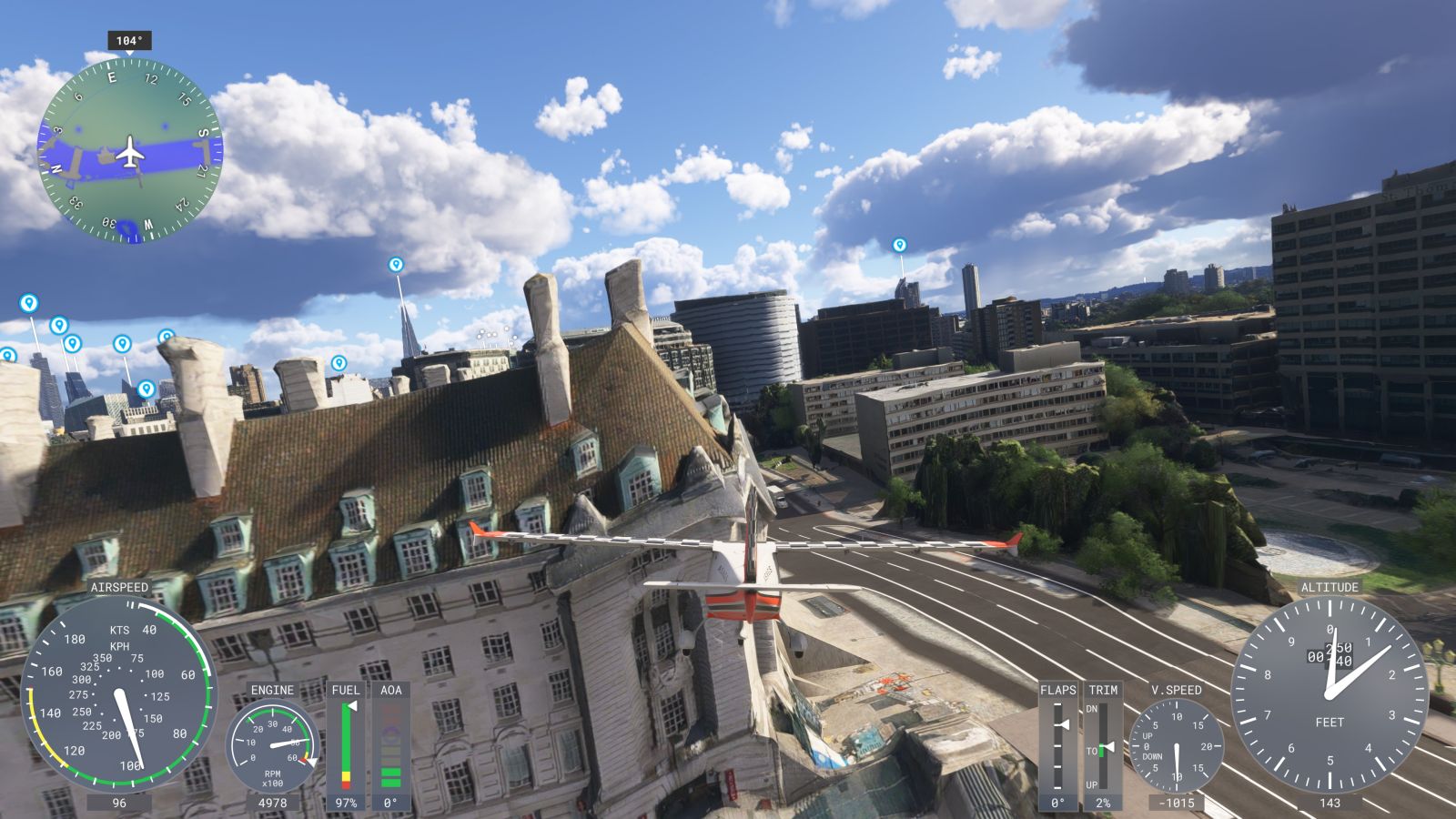
Things turn into a fun house quickly when streaming isn’t rolling correctly.
Beyond your character’s level, there are a number of ways to track your progress. Your total number of flights and flight hours, distance flown, any medals earned in the Challenge League, and photos taken in the new World Photographer mode, just to name a few, though ultimately your best litmus test is every successful takeoff and landing. As long as those two numbers are the same, you’re learning.
Activities are where you’ll practice a lot of what you’ll need to be competitive in the Challenge League. Flight Training, Rally Race, Low Altitude, and Landing Challenges are unlocked at the start, with the Red Bull Air Race, National Championship Air Races set as “coming soon”. Discovery lets you literally discover nearly 80 of the world’s most famous landmarks like Yosemite National Park, the Lofoten Islands, Lake Benmore, the pyramids in Giza, and more to cities like Tahiti, Rome, Rio De Janeiro, Reykjavik, San Francisco, and Bora Bora. Microsoft will likely expand this list greatly by the time this article hits, so I’d expect this to be an ever-evolving list. We’ll know more when the Marketplace opens – it’s currently closed as the team finishes up fixing the remaining launch issues.
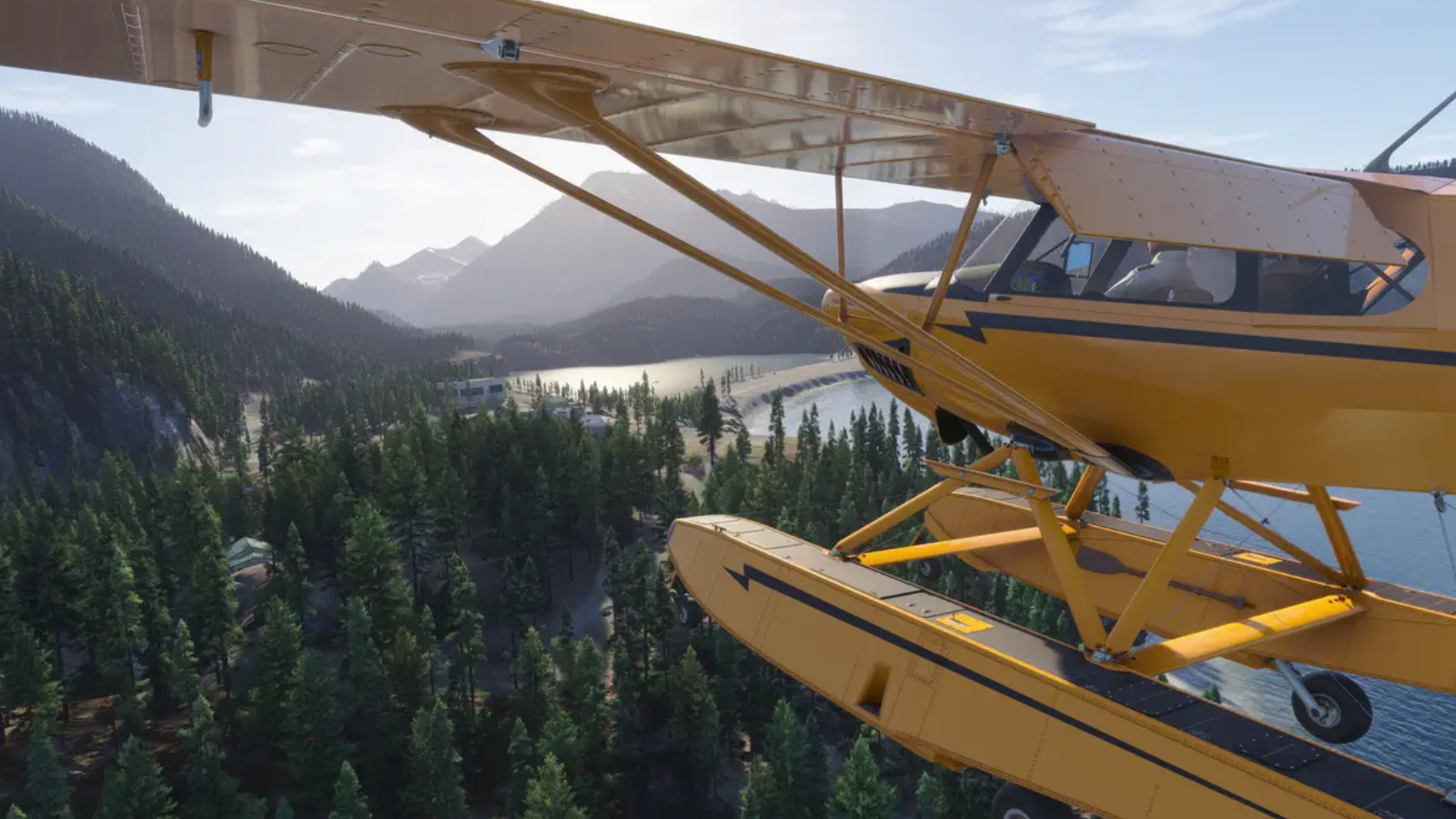
The World Photography mode is a welcome surprise. Categories like “World’s Most Famous Monuments”, “USA’s Most Spectacular Bridges”, “Iconic Sights of Asia” and “European Castle Tour” just scratch the surface of the dozens and dozens of showcase areas that’ll lead you all over the world to see the things you probably want to see anyway. Whether it’s bobbing around in a hot air balloon above Neuschwanstein Castle, rocketing around in a jet above the artificial islands of Dubai, or photographing the wealth of beautiful and exotic animals (another new thing for the series) in the Savanna are just the start of a list so long that if I filled four more paragraphs it wouldn’t even begin to do it justice. There’s something special about flying around the Pyramids of Giza, landing outside the Sphynx, walking around, and positioning the sun just off its shoulder to snap the perfect shot. New ways to play indeed.
We do need to talk about the use of AI for voice in this game. It’s equal parts unnerving, amazing, and needlessly repetitive. As you play through the career mode you’ll take passengers with you on various flights. Within half a dozen flights you’ll have heard just about everything they have to say. With an AI reading from a script, the script could be virtually unlimited and added on easily. Here, if I have to hear about how the person behind me can see their house, or how they’ll remember this for the rest of their lives, I’m going to yeet them out the side of my plane. On the other hand, it’s amazing to hear my pilot addressed by my username, and it’s very cool to have the game directly address my approach, working with air traffic control with full voiceover. Yes, it sounds robotic, but it does work well. Hopefully this is something that could be ironed out over time with an eventual more natural sound.
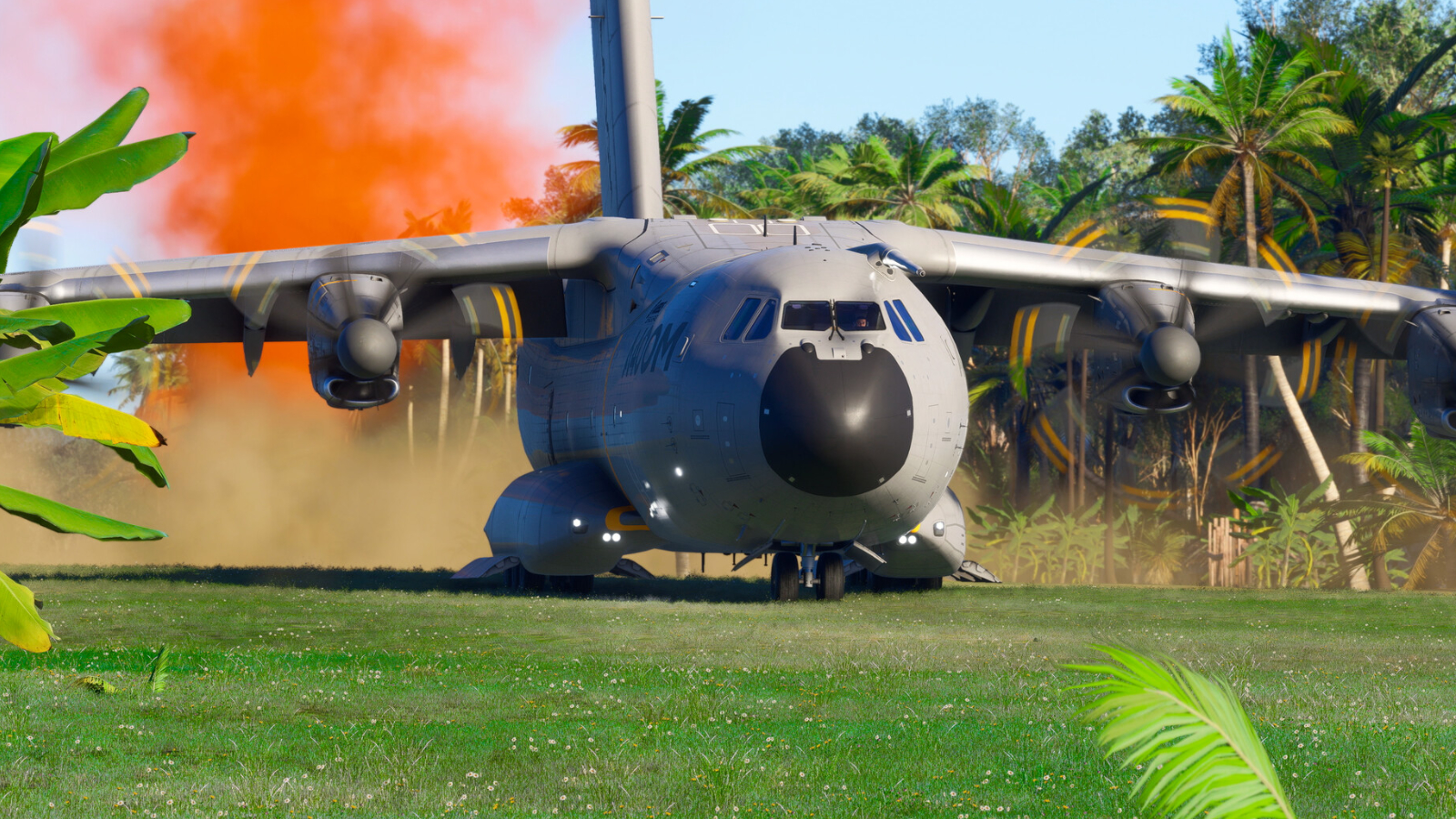
Unbelievable — that’s a screenshot!
Speaking of the Marketplace, I am happy to report that the team is going to enable everything from Flight Simulator 2020 in this newest outing. Many things are still being ported and enabled, but progress is being made in the most recent update. All of these are being slowly rolled out so they can be both streamed or installed, though the interface is a bit unintuitive to figure out how to toggle it to a local one. Though the most recent patch notes indicate that they’ve added further clarity on why certain objects are disabled, I still can’t tell you why, including Microsoft’s own Deluxe Upgrade for the previous game. Just like the bugs, this will all get ironed out over time, but it does make it rather confusing for now.
All of these new modes are a very welcome addition to the world of Flight Simulator, the true challenge is when you start turning off flight assists. The game is very user-friendly but challenging with all of the assists turned on until you learn that small movements are the best way to control your craft, but turning off the various assists and leaning into the real-world physics is the true endgame. Could you use Microsoft Flight Simulator 2024 to learn how to be a real pilot? With the right flight control surfaces and time I’m guessing you can at least pick up some good habits and understanding of the various systems that make flight possible. While I can’t say it’s as clean a takeoff as the 2020 flight, I have every confidence they’ll figure it out and stick the landing.
Microsoft Flight Simulator 2024
Great
The move to a cloud-focused game has caused some turbulence on takeoff, and it would be good to be able to decouple from that decision with an “install-all” option, but Microsoft Flight Simulator 2024 elevates the game in just about every other way. It'd just be nice if it did it more cleanly. That said, if you have even a passing interest in flight, this simulator is still the best out there.
Pros
- VR is more tightly integrated this time around
- Career mode is a very welcome addition
- Many ways to play outside of “bring your own fun” modes
- Addition of rotary craft
- Graphics are astonishing…
Cons
- …except when streaming isn’t working.
- We need an “install it all” option
- Still plenty of bugs to swat down
- Voice repetition is rampant
